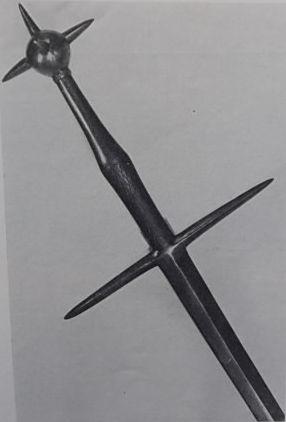Posts: 237 Location: Arlington, VA
Fri 26 Jun, 2009 3:12 pm
| Peter Lyon wrote: |
| Just to inject a bit of information about the craftsmanship needed to hand-make a thread: I had a book that I read several years ago (wish I could remember the title and knew where it has gone to) about the history and use of the thread (yes, a whole book on it!) and the author concluded that the earliest datable threads in iron(that he was aware of) dated to about 1440. The important note he made on it was that early threads had to be hand-made with chisels and files, so it was a major task to put a thread into iron (much much more work than wooden threads), moreso to thread a nut (need to make a thread-cutter in carbon steel and keep resharpening it) and that mass-produced machined threads only appear in the eighteenth and nineteenth century as a byproduct and input to industrialisation. To thread a carbon steel tang-end is even more of a pain as the chiselling stage must all be done hot, otherwise the chisel lines become fracture points, and you break off the thread and swear a lot. An early use was titling harness (bolt-on doubling plates); mostly high-end and expensive items. So having a threaded tang on a sword pre-1500 would have been partly a way of showing off, but wasn't necessarily an improvement structurally over peened tang-ends, as the threads were not precision cut and could easily loosen, even with locking nuts. |
Very interesting info. Amazing what secondary information you can sometimes pull out of the obscure niche books.
Steve
Last edited by Steven Reich on Fri 26 Jun, 2009 3:58 pm; edited 1 time in total
Posts: 232
Fri 26 Jun, 2009 3:44 pm
I was about to ask about manufacturing threads in the middle ages. Did they have a tap and dye set or were they done by hand. i can see cutting the threads with a chisel or file but how do you tap a hole using a chisel? I assume there is some trick I don't know about Hmm threading the piece while hot? granted that could back fire when the piece cools and locks on the threaded piece. One other question about threads. Being that the threads were made by hand what is the thinnest piece to be threaded or the finest pitched threads that can be made.
But the way that was written makes it seem that a thread piece was known since he didn't have to explain unscrewing something. Could he have assumed that the entire piece was threaded including the handle so thats how it would stay in place?
Posts: 249 Location: New Zealand
Sat 27 Jun, 2009 2:10 pm
| Joel Minturn wrote: |
| I was about to ask about manufacturing threads in the middle ages. Did they have a tap and dye set or were they done by hand. i can see cutting the threads with a chisel or file but how do you tap a hole using a chisel? |
Taps were used I think, but each tap had to be hand-made to match the particular thread being produced - there was absolutely no standardisation. Also threads were very course early on, which would have made locking nuts a good safety feature.
Posts: 1,422 Location: Minneapolis, MN, USA
Sun 28 Jun, 2009 2:52 pm
Threading
Thank you Peter great info.
| Peter Lyon wrote: |
| The important note he made on it was that early threads had to be hand-made with chisels and files, so it was a major task to put a thread into iron (much much more work than wooden threads), moreso to thread a nut (need to make a thread-cutter in carbon steel and keep resharpening it) and that mass-produced machined threads only appear in the eighteenth and nineteenth century as a byproduct and input to industrialisation. To thread a carbon steel tang-end is even more of a pain as the chiselling stage must all be done hot, otherwise the chisel lines become fracture points, ... |
Almost all tangs would have been iron so I do not think they would try to cut threads in steel material, if anything they may have tried to quench them after cutting but this would be highly doubtful.
| Peter Lyon wrote: |
| An early use was titling harness (bolt-on doubling plates); mostly high-end and expensive items. So having a threaded tang on a sword pre-1500 would have been partly a way of showing off, but wasn't necessarily an improvement structurally over peened tang-ends, as the threads were not precision cut and could easily loosen, even with locking nuts. |
This can be seen in many major museums, often pieces attached with very large wing nuts :)
Best
Craig
You
cannot post new topics in this forum
You
cannot reply to topics in this forum
You
cannot edit your posts in this forum
You
cannot delete your posts in this forum
You
cannot vote in polls in this forum
You
cannot attach files in this forum
You
can download files in this forum
